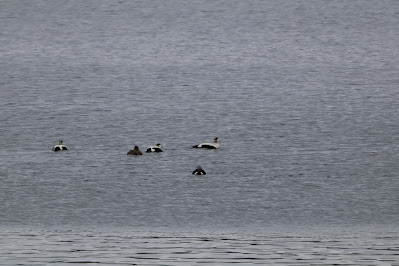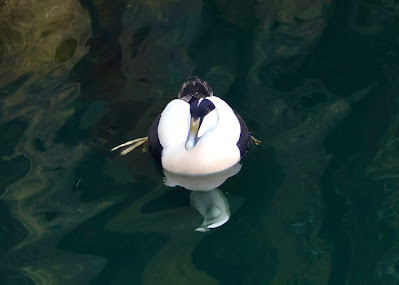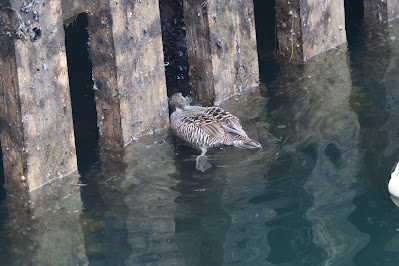This experience reminded me of a similar experience during my first trip to Costa Rica. I went back in my blog to a post titled Scarlet Macaws, dated February 24, 2014, to read what I wrote back then and look at the photos again. I wanted to see if I was remembering correctly. Yes, this was sort of like that.
It was Saturday, May 31st and if my checklist is any guide, it was one of our busiest days of birding. We started out in Båtsfjord, made several morning stops, some of which I have already named with other birds, and after a bagged lunch came to our second afternoon stop in Vadsø harbor. The vans were parked and we all piled out into the harbor area. I don't recall either guide saying, "Take your cameras. Go have fun." And we did not interrupt an intimate meeting of two lovers. That part was different. But we were here for one bird, and that part was very similar. As with the Scarlet Macaws, this will always be memorable.
I was slow on the uptake and thought we had come here for the close Common Eiders (Somateria mollissima). We had seen them before, but more distantly.
It was when the little bird bringing up the rear in the top photo turned to give a lateral view that I saw why we had come.
King Eider (Somateria spectabilis). But so far away!
The King Eider did not stay far away but first it went around the bow of a boat and disappeared under the wharf.
Above and below: Common Eider pair.
I like the rippled appearance of the surface of the water in these photos.
Those feet!
Harbors have lots of places for curious eiders to explore.
The King Eider returned from beneath the wharf and this time it was much closer.
I like the water drop at the tip of its bill.
Above: male Common Eider. Handsome in its own right.
Above: female Common Eider diving.
Above and two below: Possibly my favorites of these photos.
All of the photos above, so similar to each other, are not necessary to remind me that I saw a King Eider in Norway. Many people have seen King Eiders in Norway. However, unless I return to Norway or travel to some other arctic birding spot, I am unlikely to ever see a King Eider again. It's difficult for me to push the delete key on this bird. I have deleted many, but all of these are keepers. Such a quiet little bird.
King Eiders were seen again, most notably a flock of 65 flew by at a sea watch in Persfjord, but I don't think many of us were able to get on those. I didn't. In any event a sea watch (as already discussed in The Lighthouse) would not be like our Vadsø harbor bird.
We did, however, come across our little eider again at the park in Vardø where we saw the displaying Ruffs, the school kids on an outing and the unidentified (moose, reindeer?) skull. Circled in the photo above, it was taken from far away. Of the other birds in the photo, aside from the Common Eiders, I only recognize Common Mergansers (Mergus merganser). But the gray head (arrow pointing directly to it) and creamy breast feathers of the King Eider are very recognizable. So it was that I said goodby to my first, and most likely only, King Eider.
Personal addendum 8/02/2025
Yesterday morning I started the day learning that a Terek Sandpiper had been seen on one of the Aleutian islands on July 21st when I logged into the ABA Community site. After a busy day I capped it off with a documentary movie from Norway titled Folktales. I was driving home thinking that I should email the details of this movie to our Finland/Norway guide. Then I remembered, no, he's from Finland (even though the movie takes place in Finnmark, an area where we went). Although a couple of bird vocalizations could be heard here and there (I recognized a thrush song) and one scene showed a Siberian Jay perched at the top of a conifer tree, it was not a movie about birds. I didn't email him. I slept pretty well last night, somewhat uncommon for me. I was aware of some dreaming, but that's about it.
Recently I have been having dreams about being lost somewhere and trying to get to some other place but I have also lost my phone. So how will I ever get to wherever I need to be? It's a dream so it remains unresolved. There is always a lot of fumbling around. These have been early morning dreams so I have been able to wake myself up from them. I am relieved when I make myself wake up. Thank God it was only a dream. I always look for my phone where I leave it each night before sleeping.
This morning I was semi-awake from 4:00 - 5:00 am, but then got back to sleep. Then I remember that I opened my eyes and the clock read 6:20. I fell back asleep and began dreaming. I dreamed that I was stopped at a gas station and was speaking with someone (a friend?, it wasn't clear) and I happened to glance over at a pond that was adjacent to the gas station. I saw a male breeding plumaged King Eider paddling calmly next to a Mallard. Oh my god, oh my god, still in my olden days thinking, I have to call someone. Again a lot of fumbling around. Who should I call? I had no birders' numbers in my phone and I couldn't think of anyone's name. I kept watching the little King Eider swim placidly along. Oh wait, what am I thinking, I have the Discord app. Oh, but I'll need a photo. I began the process of trying to get a photo with my iPhone's terrible camera, reminding myself that it didn't need to be a good photo, just recognizable. As I was trying for the photo, I was trying to think of my Discord password. And so it went ... by this time I knew I was dreaming and made myself wake up. It was 8:00 am. My cat was looking at me. Feed me, she said, without using words. I was awake and the King Eider was gone.
































































